


 |
October 19-25, 1981: A Trip to San Francisco |
 |
August 19-22, 1981: A Class in New York City |
 |
Return to the Index for 1981 |
My class in New York City was only two days, and I was scheduled to go right from there to Caracas, Venezuela, to do a class for Maraven, the state oil company. I could have gone back to Chicago, but it would have been too hectic for just one night.
Getting to Caracas, Venezuela
|
I left from JFK on the 23rd of August, and returned to Chicago on September 12th. The flight down to Caracas was on the Venezuelan airline, Viasa, and was as pleasant as any other, although it was quite long- about seven hours. Venezuela is right at the top part of South America, just below the Caribbean, so it is not nearly the flight to get to Rio, say.
This was my first time in Venezuela, and so I had to learn a bit about it before I left. Located on the northern coast of South America and bordered by Colombia, Brazil, and Guyana, the 350,000-square-mile nation has a population of about 3 million. With a wide range of climatres, Venezuela has extremely high biodiversity.
The territory was colonized by Spain in 1522, and in 1811 became one of the first Spanish-American colonies to declare independence- finally established in 1821 as a part of Colombia; it gained full independence as a separate country in 1830. During the 19th century, Venezuela suffered political turmoil and autocracy, remaining dominated by regional caudillos (military strongmen) until the mid-20th century. Since 1958, the country has had a series of democratic governments.
Venezuela is a federal presidential republic consisting of 23 states, the Capital District (covering Caracas), and federal dependencies (covering Venezuela's offshore islands). Since the discovery of oil in the early 20th century, Venezuela has been thought to have oil reserves even larger than those of any Persian Gulf state. Previously an underdeveloped exporter of agricultural commodities such as coffee and cocoa, oil quickly came to dominate exports and government revenues- and, in the very recent past, has begun to suffer the problems associated with one industry controlling a nation's economy.
|
Viasa had a magazine on board that contained rather more information about the country of Venezuela and the city of Caracas than most airline magazines have about their destinations. Caracas is the capital of Venezuela and its largest city. It is located along the Guaire River in the northern part of the country, in a scenic environment where the contours of the narrow Caracas Valley (elevation: 2500 feet) parallel the Caribbean Sea, separated from the coast by a steep, 7,200-feet-high mountain range; there are more hills and mountains to the south.
Caracas has a couple million people, and so is a large metropolis. As is true of many second- and third- world cities, there are areas of extravagant wealth and areas of abject poverty, and the difference between the two is dramatic. Businesses that are located in the city include service companies, banks, and a great deal of retail, as the city has a largely service-based economy. In recent years, Maraven has become the largest company headquartered in Caracas. The city is also Venezuela's cultural capital, with many restaurants, theaters, museums, and shopping centers. Some of the tallest skyscrapers in Latin America are located in Caracas.
|
As it turned out, my hotel was located only a few blocks from one of the largest parks in Caracas- the "Parque del Este" (officially named the "Generalissimo Francisco de Miranda Park", in honor of the Venezuelan national hero). The neighborhood sits above the city by a few hundred feet, and so the views from here were pretty neat.
Caracas was founded in 1567 at the end of a series of conflicts with the indigenous peoples. In 1577 Caracas became the capital of the Spanish Empire's Venezuela Province. During the 17th century, the coast of Venezuela was frequently raided by pirates. With the coastal mountains as a barrier, Caracas was relatively immune to such attacks, although in 1595 around 200 English privateers crossed the mountains through a little-used pass, then sacked and set fire to the town.
With the expansion of cocoa cultivation and exports, Caracas grew in importance and the city expanded. Caracas was ultimately the site of the signing of a Declaration of Independence on 5 July 1811; the next year, an earthquake destroyed the city.
|
One of the very first things I did when I arrived in my room was to take a picture out the window at part of the neighborhood of Altamira. It was early morning, and the sky was threatening, so that's why things look so dismal. Fortunately, the weather improved quickly and during most of my stay was pretty good. The hotel was within walking distance of shopping and restaurants, though as it turned out I didn't need the restaurants very much. As you can see, the area around Caracas is heavily wooded and very mountainous, but I have always thought that those attributes make a city quite beautiful.
Before I came to Venezuela, I had no idea what I might do in my off hours for three weeks. I assumed there would be things to see, but I couldn't have brought enough magazines and stuff to read in the evenings for that period of time. So, I brought my Atari video game and a couple of game cartridges. I knew that television broadcasting was different outside the US, but I thought that a video game might work no matter what the type of broadcasting was, so long as the television worked the same. I found that the TVs in Caracas were just like ours in this respect, so I was able to make the Atari game work OK. Actually, I found that I didn't have as much time on my hands as I thought, but the game came in handy in the late evening when it was too late to go out and wander around the city.
In and Around Caracas, Venezuela
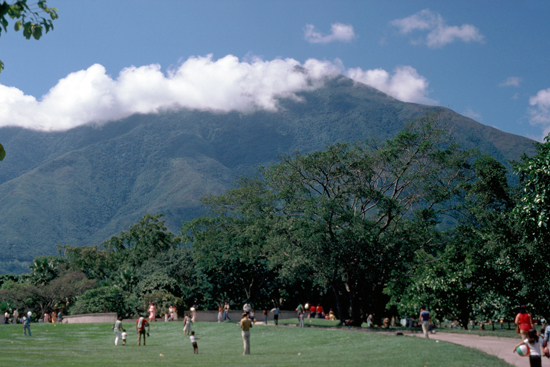 |
At the beginning of my stay in Caracas, the weather was very nice, although a bit on the warm side and very humid. This park was about ten blocks from the hotel, so I could walk over there and do my jogging. The park is very large, with walkways around and through it. I would guess that it is about the size of Lincoln Park back home, and maybe a third the size of Central Park in New York City. There are all kinds of sports fields, a museum, a small zoo and a bunch of playgrounds and stuff.
The park seemed always to be full of people, but there was a very good marked trail for runners/joggers. The city itself spreads up to the hills until the land gets too steep to try to put houses and streets on. Caracas reminded me in some respects of Honolulu, but without the ocean, which is about forty miles away.
Caracas grew in economic importance during Venezuela's oil boom in the early 20th century and during the 1950s, it began an intensive modernization program which continued throughout the 1960s and early 1970s. The Universidad Central de Venezuela, designed by modernist architect Carlos Raúl Villanueva and declared World Heritage by UNESCO, was built. New working- and middle-class residential districts sprouted in the valley, extending the urban area toward the east and southeast. The dramatic change in the economic structure of the country, which went from being primarily agricultural to dependent on oil production, stimulated the fast development of Caracas, and made it a magnet for people in rural communities who migrated to the capital city in an unplanned fashion searching for greater economic opportunity.
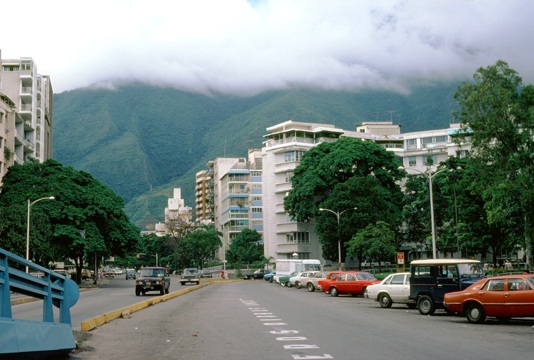 Avenida Francisco de Miranda This is a main street just north of my hotel. On many days, the clouds would descend most of the way down the mountaintops later in the day, and then sometimes it would rain, but mostly it would rain in the evening for a short time. The influence of being in a hot climate can be seen in the design and coloring of the buildings. |
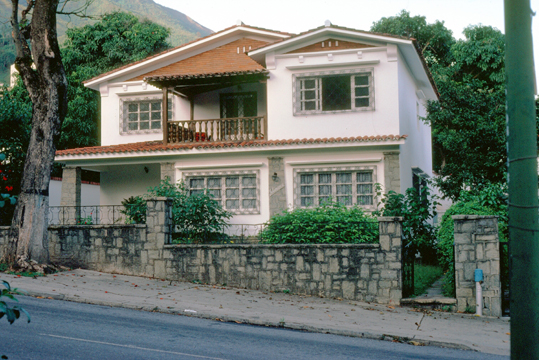 A Typical Upper-Class Residence The Altamira was in a mostly residential area. The side streets are very winding, much like the hills South of San Francisco. But many of the houses seem to be quite attractive, and certainly modern enough. I did a lot of walking and some jogging in this area, although the streets are steep enough to make jogging something of an effort. |
I must say that I thought Caracas was quite a beautiful city. Much of that was due to its setting- mountains on both side of a verdant valley. But I also have to be honest: I was staying in a nice area, and even my excursions outside Altamira were to similarly "good" areas of the city.
|
|
In the foreground are some of the single-family homes, and in the background, climbing up the sides of the hills, are some of the typical apartment buildings that you see in the city. I got to see enough of the city to know that the buildings you are looking at here are above average places to live. Again, you can see the resemblance to the pictures of Hawaii.
Panoramic Views of Caracas
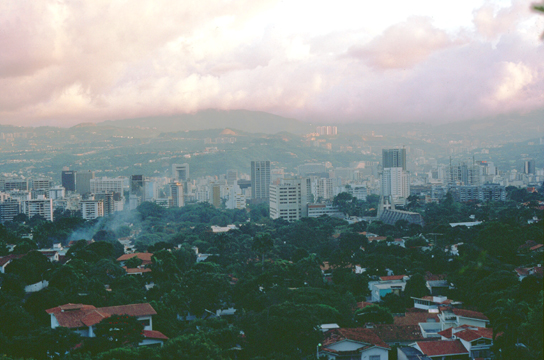 This view covers the area where I was staying, and the Altamira is the white building (does that help?) in the center left. |
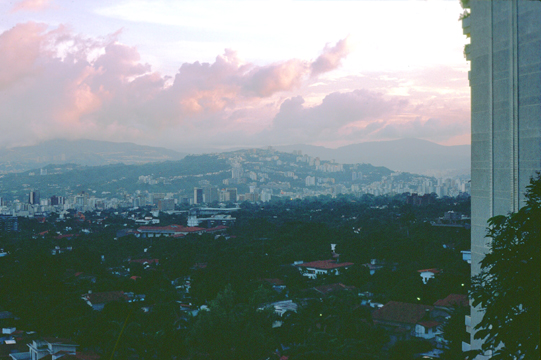 These scenic roads are very nice to drive along in good weather, and have a number of stops and overlooks so that you can see the city and the valley. |
The Maraven Classes
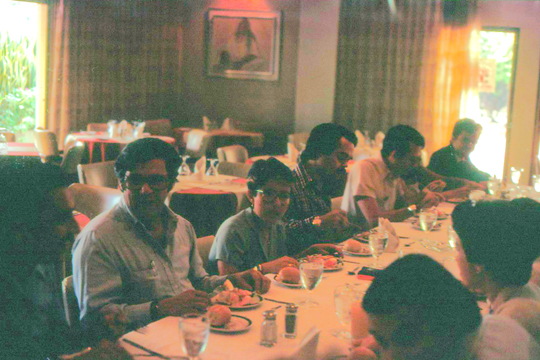 For lunch, Maraven arranged for us all to eat in the hotel dining room, and long tables set for us and with a limited menu. Here are some of the class members beginning their lunch. |
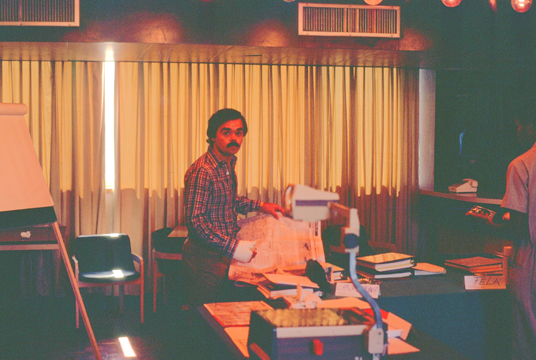 This is the classroom at the Altamira and one of the students reading the morning paper before we began the session for that day. |
I wrote most of the narrative for these pictures almost a year after I returned from Caracas, and by then I had forgotten most of the names of my class members. Actually, I only remember Victor, the guy above reading the paper, and a young lady named Lili Osipino, who actually wrote to me twice from Caracas asking about job opportunities in America. I simply passed her info over to the folks at McAuto, but I don't think anything came of it.
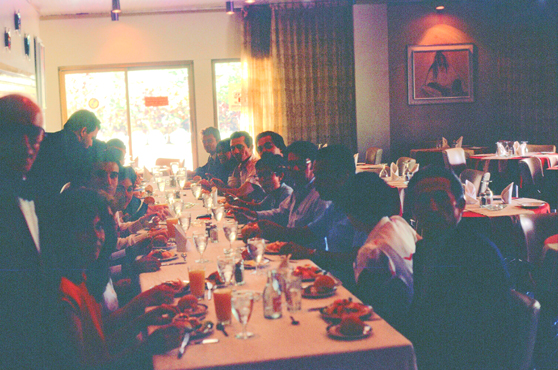 Part of the Class at Lunch in the Altamira The small pool area of the Altamira was right outside. |
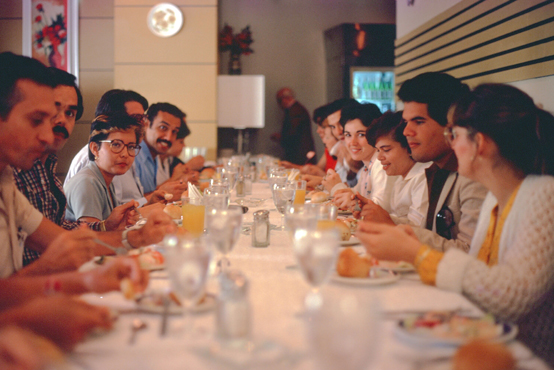 Another Picture of Part of the Class at Lunch The lunch break was two hours, so sometimes I would eat hurriedly and then go out and get some sun for a while. |
Maraven did a bang up job with the arrangements for the class. I thought they were lavish, but I understand that this is simply the way business is done in South America. When the class arrived in the morning at nine, there was coffee, juice, croissants, rolls, jams and jellies waiting. At mid-morning, the hotel refreshed all of that and added some small sandwiches. Lunch was a catered affair in the hotel dining room, and was a full-course meal with wine. When the class returned to the classroom, there were more little sandwiches, coffee and sodas. In mid-afternoon, the hotel brought cookies, petit-fours and a cake or pie for the students to dig into. In addition, there were bowls of candies on the tables. This is why I didn't need to go out and find dinner anywhere. I was so stuffed by the end of the day that all I wanted to do was take a nap and then do some exercises to try to work off all the calories. I did gain some weight while in Caracas, but actually not enough to speak of.
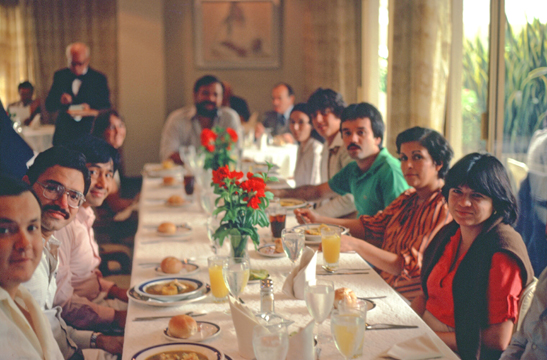 There were two different classes this week, although a few of the students in my first one were in the second as well. Here is a picture of some of the second class at lunch. |
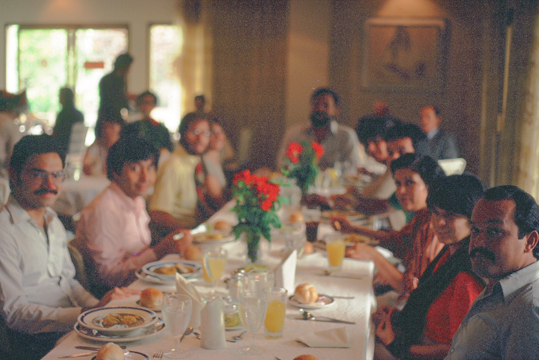 Here is the second class at lunch again; the person I asked to take the picture didn't focus it very well. Sadly, it was the only one I was in (on the left side of the table most of the way to the back). |
The only problem with the classes, other than the fact that one class was relatively new to me, was that many of the students did not speak English much, and of course I did not speak Spanish, so I had to talk slowly and explain myself quite a bit. That is perhaps why Maraven wanted to spread each class out over two extra days. Greg had been here before to do a class for Maraven, and many of these people had attended one of his classes. I recall apologizing for the fact that I understood that Greg had taught his course in Spanish but that I did not know the language. The young lady in the class spoke up, though, and said that Greg taught his class in Mexican, not Spanish, which I found very humorous. There were a few times when it was difficult to make myself understood, but not often.
Around the Altamira Hotel
|
|
The weather in Caracas is often best earlier in the day, as by the end of the day the humidity has had a chance to build and the clouds form. You can't see my room from here; it was on the front about halfway up the hotel. The class was being held in the penthouse room on the top floor of the hotel.
In 1944, Luis Roche ordered (with permission of the government) the construction of many avenues and the square. Roche wanted the square's obelisk to be "higher than the Cathedral of Caracas". The square was completed in 1945 and was originally called Plaza Altamira. In 1967 the Venezuelan and French governments agreed to rename Plaza Altamira to Plaza Francia (France Square in Spanish). The French government built a Plaza Venezuela in their country in 1975.
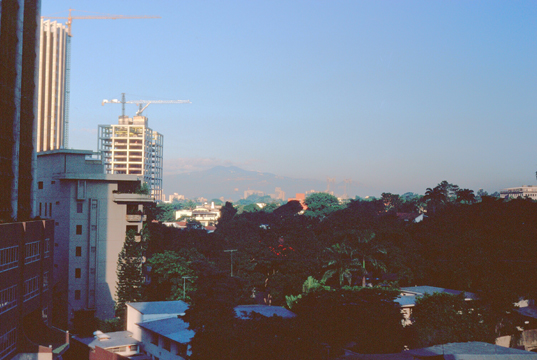 Here is another view from the Altamira, this one from the Penthouse level looking South, I believe. |
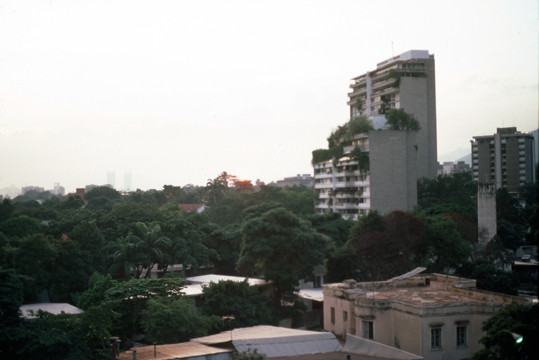 Here is the residential area around the Altamira. In the far distance you can see some of the taller buildings in the very center of Caracas. |
A Weekend Trip to Cayo Sombrero
|
When I talked with him, I discovered that SEI was also doing work for Maraven, and had placed two of their employees, Mark and Andy, at Maraven's offices in Caracas. Rick told me they were nice guys and that I should get in touch with them, as they knew their way around. My friend Greg had met Mark and Andy as well when he was here, and they had done a few things together.
So I did contact the guys, and they were very anxious to answer any questions I had about things to do in Caracas, and also thought that I might like to join them on one of their weekend outings outside the city. As it turned out, they had planned an upcoming weekend trip to Morrocoy National Park up north on the coast, and planned to spend a weekend there on a small island in the park called Cayo Sombrero. This sounded like fun, and when they invited me along I accepted.
|
Andy, Colin and Albert arrived very early in the morning, and we packed up a rented van and headed off northwest to the town of Silva- about fifty miles from Caracas. The drive was neat and I got a chance to learn more about the kinds of work that Mark, Andy and Colin were doing for Maraven. Mark and Andy were here on long-term assignment, so each of them had gotten a small apartment in Caracas, and by now they were very knowledgeable about the city. They all said it was a shame that I was only here for a few weeks, as the city was very cosmopolitan with lots to do and see.
Past Silva, we turned off on a narrow road that led out to the national park, but before we got there, we stopped at a small town where Andy had arranged for a boat to take us all out to the island (and pick us up tomorrow afternoon). I already knew that the guys had brought two tents and that we'd be roughing it for the weekend. I'd share one with Mark and Andy, while Colin and Albert occupied the other.
Anyway, we reached the ocean about ten in the morning, and hired a launch to take us out to the island and pick us up on Sunday afternoon.
|
Morrocoy National Park is relative new, having been created only six or seven years ago. The 32,000-acre park has three "sections"- one near Silva, one at the end of the spur of land north of Silva, and a number of offshore islands and keys- including Cayo Sombrero (Sombrero Island).
The park extends across both terrestrial and aquatic areas of Golfo Triste (actually a relatively small, partially sheltered, body of water). It contains an area of mangroves and numerous islets or cays among which are Borracho, Muerto, Sombrero, Sal, Las Animas and Peraza, among others. There are spectaculars white sand beaches on these cays; Mero, Paiclas, los Juanes, Playuela, Tucupido, Azul, Boca Seca and many more. The park's internal bays and mangroves, cays and islands sit in the relief of Chichiriviche hills, with elevations of 800 feet.
You'll eventually get to see all the guys that were along on the trip this weekend, but I took pictures of two of them on the way out to Cayo Sombrero. I did not remember Albert's last name, but I did find out that he is Venezuelan.
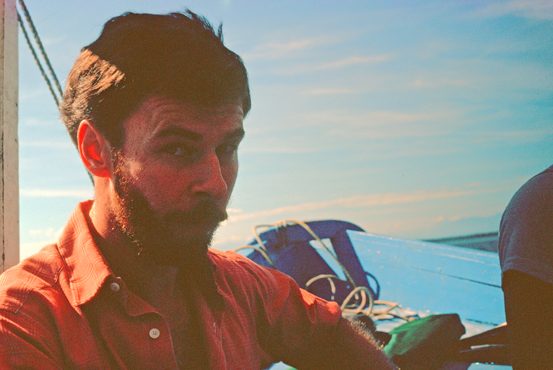 Colin Clark |
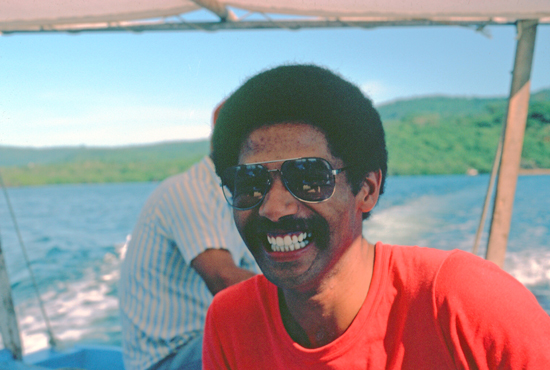 Albert |
I also discovered relatively soon (actually on the drive out here from the city) that Colin and Albert had a relationship going, as Colin, too, had been here in Caracas for some time. Being new to all of this, I was curious about how these relationships worked, and both Colin and Albert were happy to tell me about their experiences. Since Mark and Andy were also aware of their situation, there was no tension about these topics during the weekend.
The trip out to Cayo Sombrero took about forty-five minutes, and it was a lot of fun.
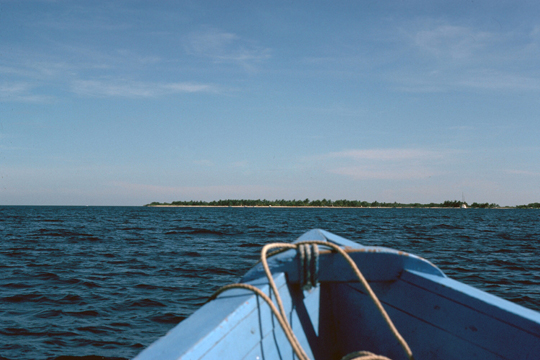 Sombrero Island The area here is low and sandy, like Florida, but the water was clean and shades of deep blue- like Hawaii. |
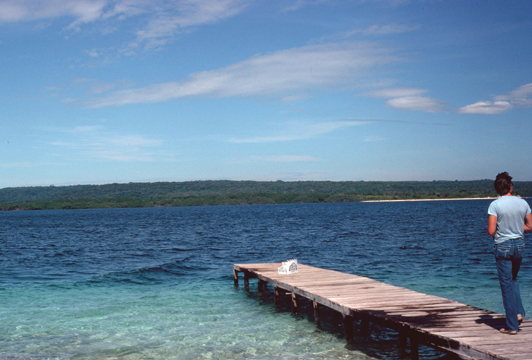 The Pier on Cayo Sombrero The launch dropped us off at this pier, and Mark going out to retrieve the last of the supplies that we brought along. |
The day was very warm, but not too humid. One main problem with this time of year on this particular island were the mosquitoes, but I had been warned to bring along some insect repellent, and I bought some at a drugstore near the hotel, so even though they were a nuisance, they didn't ruin the weekend. They certainly didn't detract from the scenery:
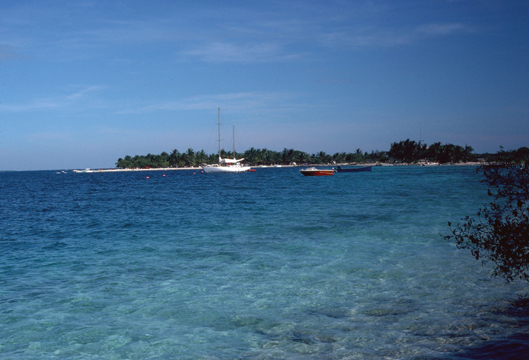 Being in the South Caribbean, Sombrero Island attracts a lot of people who have their own boats, and these are some of the sailboats and power boats that were in the area. |
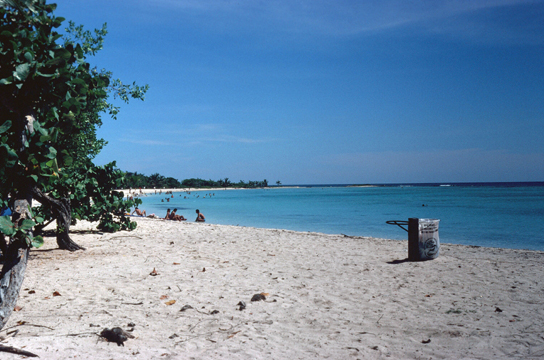 Cayo Sombrero is a typical Caribbean island- low and sandy. It is heavily used most of the year, and there was some littering, but it was mostly clean. Those are the guys way down the beach. |
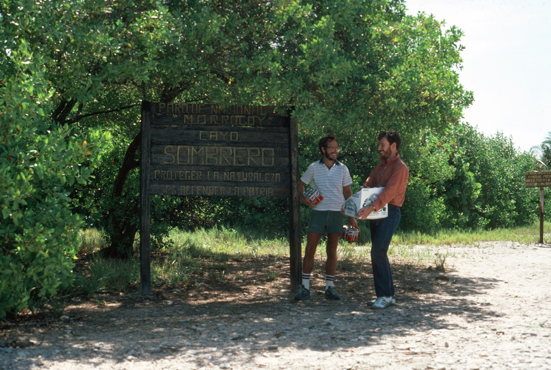 Here are Colin and I standing beside the sign that identifies this as Cayo Sombrero. |
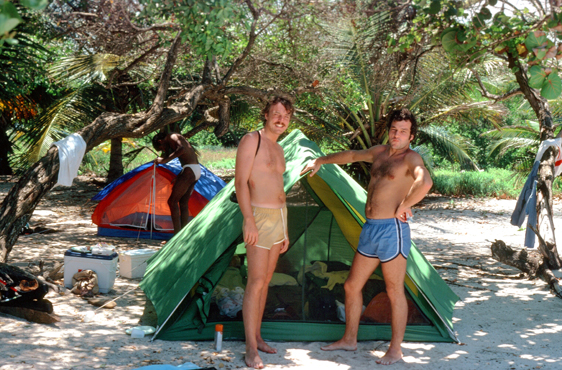 Here are Mark and Andy standing in front of the tent the three of us used. |
In the picture of Mark and Andy above, note the can of insect repellent on the ground by Mark. The tents had mosquito netting, but even so, we had to use the insect repellent at night because they invariably got into the tent as well.
|
|
Camping out here on Cayo Sombrero was actually my first introduction to camping at all. I am pretty much a city person, and I was just a little apprehensive about roughing it, but it turned out to be very enjoyable. The national park provided the equivalent of portable toilets, but there was no running water, so we had to bring our own.
But I thought the whole experience was really neat (although I probably wouldn't want to be away from modern conveniences for more than three or four days at a stretch). I also found myself thinking that camping would be even more enjoyable if one were in a mountainous or forested area, or if the weather were cooler. Tony and I slept out in the open on our drive across country a few years ago, but that wasn't the same thing at all. I will look forward to trying this again.
I had also brought my little portable backgammon board, and some of us played. I think it was Colin and Mark who already knew how to play, and we spent some time teaching Andy and Albert. All and all, I really enjoyed the weekend, and on Sunday I made sure that Mark and Andy, whose idea this had been, knew how much I'd enjoyed it. The launch arrived to pick us up about four in the afternoon, and we reluctantly struck camp and headed back.
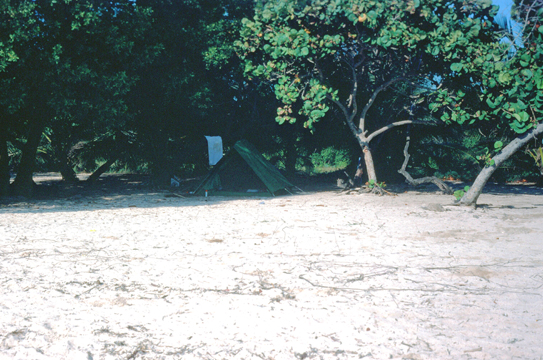 Here's our camp, although you can't see the tents clearly. |
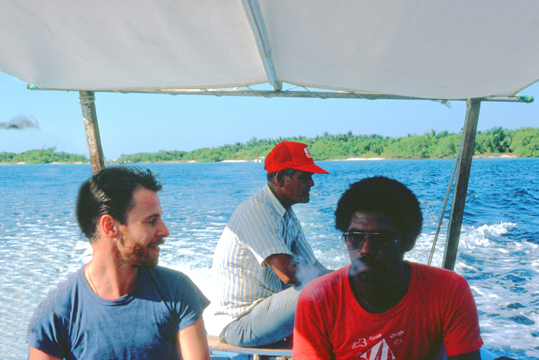 Here we are on the way back- Colin, the launch pilot, and Albert. |
Mark and Andy, the experienced campers, did most of the planning and directing, and the rest of us pitched in. I just pounded the stakes where they said to. The weekend was really enjoyable, with our time in the sun, our cookout on Saturday night, and the backgammon. Even so, I would probably get bored though if I had to spend a week out here doing nothing. The ride back to Caracas was equally enjoyable, although we were all looking forward to showers. Mark was nice enough to drop me off at the Altamira Hotel.
Heading Home from Caracas
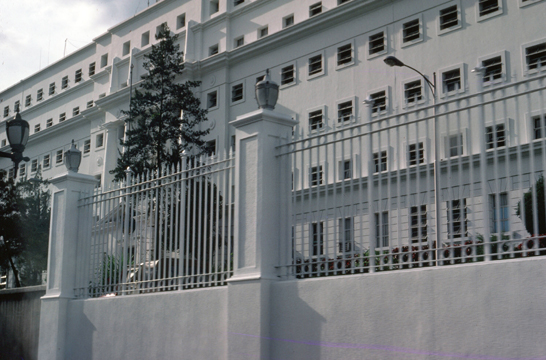 The Building Where Maraven's Offices are Located |
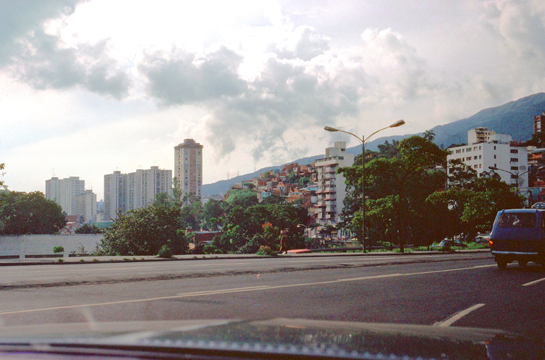 A Caracas Street Scene Near the Altamira |
The rest of my pictures were taken on the cloudy Saturday as my taxi drove me back to the airport:
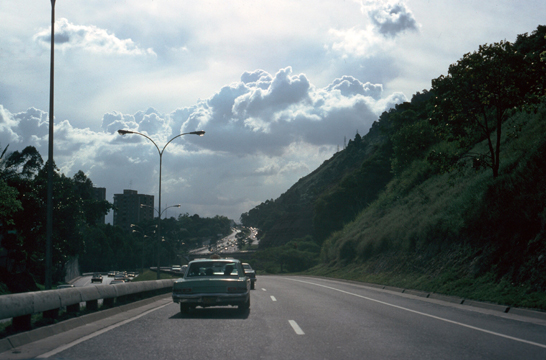 This high up on the mountainside, it is too steep for houses or apartment buildings, so the major highway is here. |
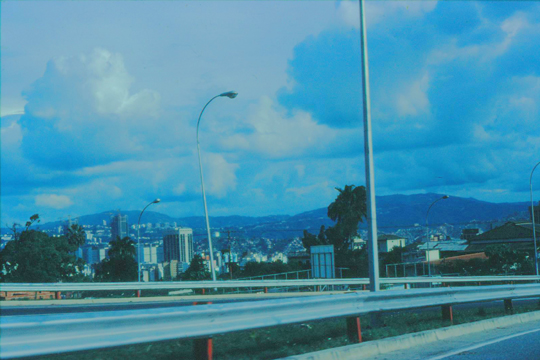 Caracas as Seen From the Airport Highway |
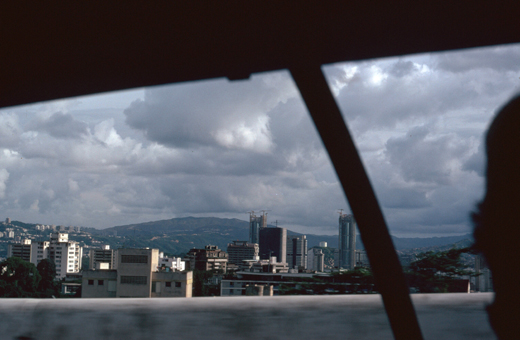 This is Caracas, seen from the mountain highway that leads to the airport. |
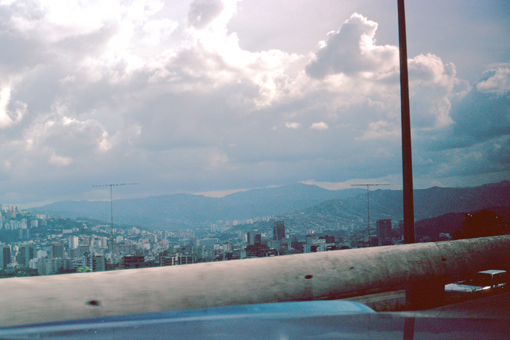 This is the outskirts of Caracas, taken from the highway to the airport. |
Most of the places I saw in Caracas were upper class areas. Certainly the area where the hotel was located was a nice area to live, and few trips took me outside these areas. It is important to remember, though, that the entire city is not so nice; there are poorer sections of Caracas as there are in every major city.
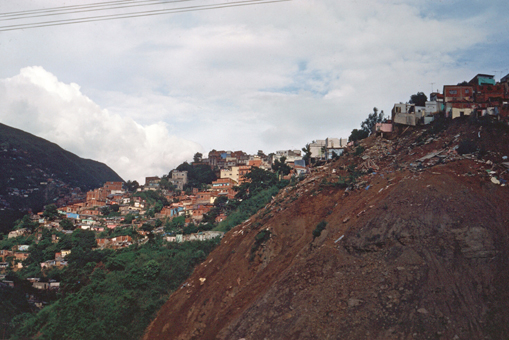 A Poor Area of Caracas at the City's Western Edge |
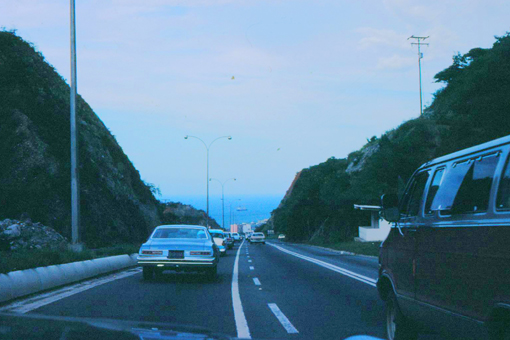 The Highway Leading Down to the Airport |
You may remember that I mentioned that I took my Atari game with me, not knowing that there would be so much to see and do. While I was wandering around the shopping areas, I saw the same game that I had bought for about $90 in Chicago on sale in Caracas for $300. The difference is due to the high level of customs duty that is placed on most items made abroad. While I was in the airport waiting for my flight home, I saw that incoming Venezuelans from the States were carrying as many goods as they could, since these are duty-free up to a point.
While I was standing there, a Venezuelan man came up to me and asked me if I was on my way home. He was well-dressed and obviously not a panhandler, so I replied that I was. He then asked me if I would be willing to sell my Atari game to him for $220 in American money. Since I knew that I could go to any store at home and get another, newer one, I said sure, and we struck a deal. That meant that I didn't have to lug the thing home and I doubled my money besides. As it turned out, I never bought another one, because I traveled so much in the upcoming months that I never found the spare time to spend with it.
You can use the links below to continue to another photo album page.
 |
October 19-25, 1981: A Trip to San Francisco |
 |
August 19-22, 1981: A Class in New York City |
 |
Return to the Index for 1981 |